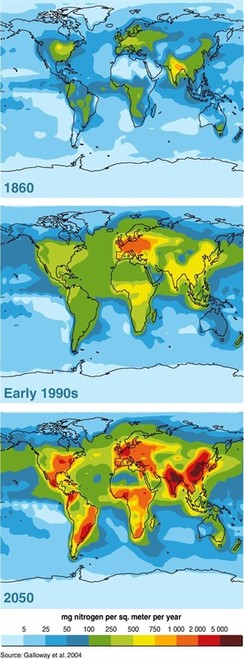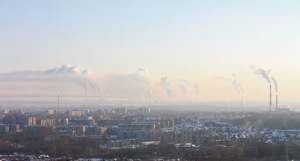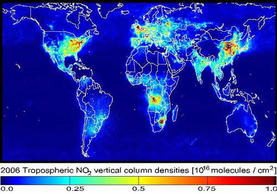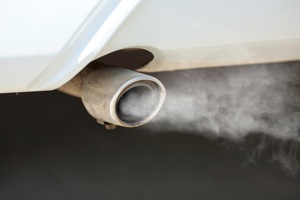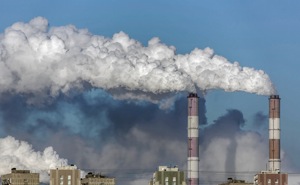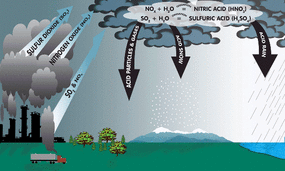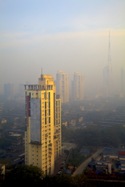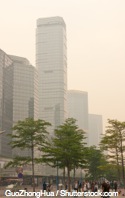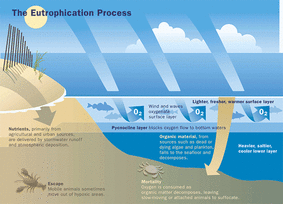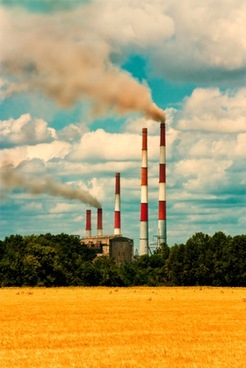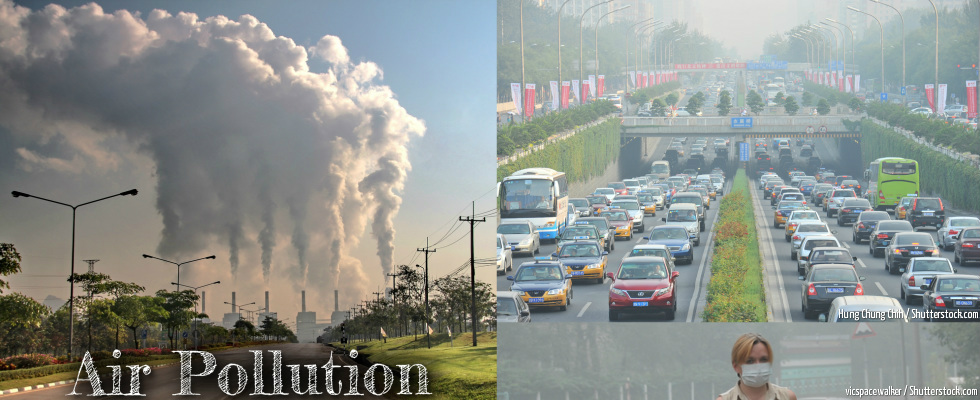
Air Pollution
Both indoor and outdoor air pollution is a
major environmental health problem
affecting everyone in developed and developing countries alike. Outdoor air pollution alone is
responsible for over 3 million deaths each year.
According to the World Health Organization, air pollution is contamination of the indoor or outdoor environment by any chemical, physical or biological agent that modifies the natural characteristics of the atmosphere. The burning of
coal,
oil
and other
fossil fuels,
pesticide use, household combustion devices, motor vehicles, mining operations, industrial facilities, forest fires and manufacturing chemicals are
common sources of air pollution. Air pollution has been
associated to an increased number of deaths among patients who have been admitted to a hospital with heart attacks,
linked to autism
and
contributes to asthma, emphysema, heart disease, and other potentially lethal conditions
and isn't exclusive to it's origin as it travels long distances through trade winds. For example, if you live in California and are listening to the news about how
horrible the air pollution in China is
- you should know that
prevailing winds are carrying those same airborne particles to Japan
and
all the way to you, in California
(see also). Even
ship pollution can be tracked from space and has led to cardiovascular and respiratory problems in humans. By reducing air pollution levels, especially
particulate matter
which affects people the most, we can help countries reduce the global burden of disease from respiratory infections, heart disease, and lung cancer. Hazardous air pollutants may cause cancer or other serious health effects, such as birth defects or reproductive effects, or have adverse ecological effects. Although there are
187 hazardous air pollutants
under watch by the EPA, we will take a look at
six of the most common and harmful pollutants to human health. The origins of these
air toxins come from human-made sources, such as carbon dioxide, which exacerbates the ability for air toxins to accumulate and form
by increasing the air temperature and water vapor in the atmosphere, which feed back to increase ground-level ozone concentrations
and overall air pollution.
According to the EPA, sources of air pollution include stationary sources, such as
factories, refineries and power plants, mobile sources, such as
cars, trucks and buses
and
indoor sources, such as cooking and heating with solid fuels on open fires or traditional stoves.
Learn more.
"Clean air is essential to life and good health. Air pollution aggravates asthma, the number one children's health problem. Air pollution also causes disease and even premature death among vulnerable populations, including children, the elderly, and people with lung disease. A 1996 analysis by the Natural Resources Defense Council of studies by the American Cancer Society and Harvard Medical School suggests that small particles in the air may be responsible for as many as 64,000 deaths each year from heart and lung disease. Air pollution is responsible for more deaths than motor vehicle accidents, and ranks higher than many other serious health threats." ~ Union of Concerned Scientists
10 Air Pollution Facts
Estimated total reactive nitrogen deposition from the atmosphere (wet and dry) in 1860, early 1990s, and projected for 2050. See why
scientists are worried about nitrogen's effects. Source:
UNEP/GRID
According to a
study published in Atmospheric Chemistry and Physics, an Open Access journal of the European Geosciences Union (EGU), most of the world's population will be subject to degraded air quality in 2050 if human-made emissions continue as usual. In this 'business-as-usual' scenario, the average world citizen 40 years from now will experience similar air pollution to that of today's average East Asian citizen.
In the UK,
car emissions claim more lives than car accidents
and are responsible for
7500 early deaths annually.
"Motor vehicles create more dirty air nationwide than any other source—about one-third of all air pollution in the United States." ~ American Lung Association
"Motor vehicles create more dirty air nationwide than any other source—about one-third of all air pollution in the United States." ~ American Lung Association
Six Hazardous Air Pollutants to Human Health
Particulate Matter (PM)
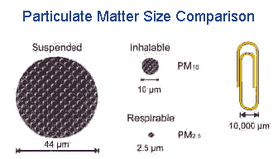
Source: HES - Air Quality Management Division
Particulate matter, consisting of
carbon-based particles, dust, and airborne acid droplets, affects more people than any other pollutant.
Vehicles, like our cars and SUVs, produce particulates, as do smoke stacks at factories and power plants and even gas powered lawn mowers and leaf blowers. According to
WHO, particulate matter is particularly dangerous because it can reach the peripheral regions of the bronchioles, and interfere with gas exchange inside the lungs. As
WHO explains, "Chronic exposure to particles contributes to the risk of developing cardiovascular and respiratory diseases, as well as of lung cancer. In developing countries, exposure to pollutants from indoor combustion of solid fuels on open fires or traditional stoves increases the risk of acute lower respiratory infections and associated mortality among young children. The mortality in cities with high levels of pollution exceeds that observed in relatively cleaner cities by 15–20%. Even in the EU, average life expectancy is 8.6 months lower due to exposure to PM2.5 produced by human activities." According to a study published in the ACS journal Environmental Science & Technology by MIT researchers,
particulate matter of 2.5 micron (PM 2.5) emitted by the combustion of fossil fuel is responsible for around 13,000 premature deaths in the UK per year.
Learn more.
Ground Level Ozone (O3)
Ozone occurs in two regions of the Earth's atmosphere: at the ground level, where ozone is the main component of smog, and in the upper regions of the atmosphere, where ozone protects the earth from the sun's harmful rays.
Ground level ozone is formed by the reaction of sunlight with pollutants, such as nitrogen oxides, from vehicles, industry emissions and volatile organic compounds emitted by vehicles and industry. The highest levels of ozone pollution occur during periods of sunny weather.
Exposure to unhealthful levels of ozone sears the lungs
potentially producing significant decreases in lung function, inflammation of the lung lining and pain when breathing, and is associated with hospital admissions and emergency room visits for respiratory problems.
It can cause breathing problems, trigger asthma, reduce lung function and cause lung diseases.
Learn more.
NSC: Ground Level Ozone
Nitrogen Dioxide (NO2)
Nitrogen Dioxide is a gaseous air pollutant
produced by fossil fuel combustion processes, such as heating, power generation, and engines in vehicles and ships. According to the
World Health Organization, epidemiological studies have shown that symptoms of bronchitis in asthmatic children increase in association with long-term exposure to nitrogen dioxide and reduced lung function growth is also linked to nitrogen dioxide at concentrations currently measured or observed in cities of Europe and North America.
Nitrogen dioxide can destroy organic matter, such as human tissue. Exposure to high concentrations of nitrogen dioxide can
make living organisms more susceptible to bacterial infections and lung cancer.
Learn more.
Volatile Organic Compounds (VOC)
 VOCs are among the leading indoor air pollutants. According to the
EPA, volatile organic compounds are emitted as gases from certain solids or liquids. Concentrations of many VOCs are consistently higher indoors (up to 10x higher) than outdoors. VOCs are emitted by a wide array of everyday products numbering in the thousands.
Examples
include paints and lacquers, paint strippers, cleaning supplies, pesticides, building materials and furnishings, office equipment such as copiers and printers, varnishes, and wax all contain organic solvents, as do many cleaning, disinfecting, cosmetic, degreasing, and hobby products. Since
fuels are made up of organic chemicals, all of these products can release organic compounds while in use and to some degree - when they are stored.
Health effects
include eye, nose, and throat irritation, headaches, loss of coordination, nausea, damage to liver, kidney, and central nervous system. Some organics can cause cancer in animals and some are suspected or known to cause cancer in humans. According to the
EPA, "Key signs or symptoms associated with exposure to VOCs include conjunctival irritation, nose and throat discomfort, headache, allergic skin reaction, dyspnea, declines in serum cholinesterase levels, nausea, emesis, epistaxis, fatigue, dizziness." VOCs can also contaminate water and food supplies.
Learn more.
VOCs are among the leading indoor air pollutants. According to the
EPA, volatile organic compounds are emitted as gases from certain solids or liquids. Concentrations of many VOCs are consistently higher indoors (up to 10x higher) than outdoors. VOCs are emitted by a wide array of everyday products numbering in the thousands.
Examples
include paints and lacquers, paint strippers, cleaning supplies, pesticides, building materials and furnishings, office equipment such as copiers and printers, varnishes, and wax all contain organic solvents, as do many cleaning, disinfecting, cosmetic, degreasing, and hobby products. Since
fuels are made up of organic chemicals, all of these products can release organic compounds while in use and to some degree - when they are stored.
Health effects
include eye, nose, and throat irritation, headaches, loss of coordination, nausea, damage to liver, kidney, and central nervous system. Some organics can cause cancer in animals and some are suspected or known to cause cancer in humans. According to the
EPA, "Key signs or symptoms associated with exposure to VOCs include conjunctival irritation, nose and throat discomfort, headache, allergic skin reaction, dyspnea, declines in serum cholinesterase levels, nausea, emesis, epistaxis, fatigue, dizziness." VOCs can also contaminate water and food supplies.
Learn more.
Carbon Monoxide (CO)
Carbon monoxide
is an extremely toxic gas which affects the ability of the body to receive oxygen by reducing the amount of hemoglobin, which transports oxygen in the blood, leading to a shortage of oxygen in the body.
Sources of carbon monoxide
include automobile, truck, or bus exhaust from garages, nearby roads, or parking areas, worn or poorly adjusted and maintained combustion devices, such as boilers and furnaces, tobacco smoke, unvented kerosene and gas space heaters, back-drafting from furnaces, gas water heaters, wood stoves, fireplaces, gas stoves, generators and other gasoline powered equipment.
Carbon monoxide exposure
may cause headache, dizziness, irritability, confusion, memory loss, disorientation, nausea and vomiting, abnormal reflexes, difficulty in coordinating, difficulty in breathing, chest pain, cerebral edema, convulsions, seizures, coma and death. Carbon monoxide pollution is especially harmful to weaker, more vulnerable people, specifically to those with heart and lung diseases. Perhaps the most dangerous part of this gas is that it is
invisible and odorless, which can make it a silent killer due to a lack of detectability.
Learn more.
Sulfur Dioxide (SO2)
According to the
EPA, sulfur dioxide is one of a group of highly reactive gasses known as “oxides of sulfur.” The
largest sources of SO2 emissions
are from fossil fuel combustion, such as oil and coal, at power plants (73%) and other industrial facilities (20%).
Smaller sources of SO2 emissions
include industrial processes such as extracting metal from ore, and the burning of high sulfur containing fuels by locomotives, large ships, and non-road equipment. SO2 is linked with a number of adverse effects on the respiratory system. According to the
World Health Organization, SO2 can affect the respiratory system and the functions of the lungs, and causes irritation of the eyes. Inflammation of the respiratory tract causes coughing, mucus secretion, aggravation of asthma and chronic bronchitis and makes people more prone to infections of the respiratory tract. Hospital admissions for cardiac disease and mortality
increase on days with higher SO2 levels. When SO2 combines with water,
it forms sulfuric acid; this is the main component of acid rain which is a cause of deforestation.
Learn more.
"Poor indoor air quality may pose a risk to the health of over half of the world’s population. In homes where biomass fuels and coal are used for cooking and heating, Particulate matter levels may be 10–50 times higher than the guideline values. Significant reduction of exposure to air pollution can be achieved through lowering the concentrations of several of the most common air pollutants emitted during the combustion of fossil fuels. Such measures will also reduce greenhouse gases and contribute to the mitigation of global warming." ~ World Health Organization
| |
Environmental Effects of Air Pollution
Acid rain
Acid rain, also called acid deposition, is formed primarily by air pollution from nitrogen oxides and sulfur oxides released into the atmosphere when fossil fuels, such as coal and oil, are burned causing precipitation to contain harmful amounts of nitric and sulfuric acids. These acids fall to the Earth either as wet precipitation, such as rain, snow, or fog, or as dry precipitation, such as gas and particulates.
Some are carried by the wind, sometimes hundreds of miles. In the environment, acid rain causes the acidification of
sensitive forest soils,
streams, lakes and rivers, making the water unsuitable for some fish and other wildlife
and contributes to the
damage of trees
by robbing them of nutrients, stifling new growth and killing many of the seedlings, which makes them more susceptible to other environmental threats, and causes damage to the roots potentially leading to the trees death. Furthermore, acid rain causes
corrosion of metals, such as bronze, the deterioration of paint and stone
and even
automotive paints. It also speeds the decay of buildings, statues, and sculptures and contributes to
visibility degradation
and
harms public health.
Learn more.
Source: NYS DEC
| Click to Enlarge
"Human use of Earth’s natural resources is making the air, oceans, freshwaters, and soils more acidic, according to a U.S. Geological Survey – University of Virginia study available online in the journal, Applied Geochemistry. This comprehensive review, the first on this topic to date, found the mining and burning of coal, the mining and smelting of metal ores, and the use of nitrogen fertilizer are the major causes of chemical oxidation processes that generate acid in the Earth-surface environment. These widespread activities have increased carbon dioxide in the atmosphere, increasing the acidity of oceans; produced acid rain that has increased the acidity of freshwater bodies and soils; produced drainage from mines that has increased the acidity of freshwater streams and groundwater; and added nitrogen to crop lands that has increased the acidity of soils." ~
U.S. Geological Survey
View Study
Haze
Haze is caused when
sunlight encounters tiny pollution particles in the air obscuring the clarity, color, texture, and form of what we see. Some haze-causing pollutants are directly emitted to the atmosphere by sources such as power plants, industrial facilities, trucks and automobiles.
Every year in the U.S., there are over 280 million visitors to the nation's most treasured parks and wilderness areas. Many of these visitors aren't able to see the spectacular vistas they expect because the visual range has been substantially reduced by air pollution.
In eastern parks, average visual range has decreased from 90 miles to 15-25 miles. In the West, visual range has decreased from 140 miles to 35-90 miles. During much of the year a veil of white or brown haze hangs in the air blurring the view.
Most of this haze is not natural. It is air pollution, carried by the wind often many hundreds of miles from where it originated.
However, the effects of haze are far more than just spoiling beautiful views and aren't restricted to natural areas. According to the
EPA, some of the pollutants which form haze have also been linked to serious health problems and environmental damage. Exposure to very small particles in the air have been linked with increased respiratory illness, decreased lung function, and even premature death. In addition,
particles such as nitrates and sulfates contribute to acid rain formation which makes lakes, rivers, and streams unsuitable for many fish, and erodes buildings, historical monuments, and paint on cars.
Learn more.
Eutrophication
Image Credit: Pew Trusts
| Click to Enlarge
Eutrophication, a rapidly growing environmental crisis, is a condition in a water body where high concentrations of nutrients, such as nitrogen, stimulate blooms of algae, which in turn can cause fish kills and loss of plant and animal diversity.
Although eutrophication is a natural process in the aging of lakes and some estuaries, human activities, such as the burning of fossil fuels, can greatly accelerate eutrophication
by increasing the rate at which nutrients enter aquatic ecosystems.
Air emissions of nitrogen oxides from power plants, cars, trucks, and other sources
and the
rapid increase in intensive agricultural practices
contribute to the amount of nitrogen entering aquatic ecosystems. According to the
World Resources Institute, "In coastal areas, occurrences of dead zones, which are caused by eutrophic conditions, have increased from 10 documented cases in 1960 to 405 documented cases in 2008. In addition, many of the world’s freshwater lakes, streams, and reservoirs suffer from eutrophication; in the United States, eutrophication is thought to be the primary cause of freshwater impairment. Many of our largest freshwater lakes are entrophic, including Lake Erie (United States), Lake Victoria (Tanzania/Uganda/Kenya), and Tai Lake (China). The increase in eutrophication is the result of human activities. Major sources of nutrients to freshwater and coastal ecosystems include wastewater, agriculture, and atmospheric deposition of nitrogen from burning fossil fuels. The drivers of eutrophication are expected to increase for the foresee- able future." The Millenium Ecosystem Assessment found that
human activities have resulted in the near doubling of nitrogen and tripling of phosphorus flows to the environment
when compared to natural values.
Learn more.
Crop and Forest Damage
Nearly all areas of the world have trees and crops damaged from air pollution in a variety of ways. Ground-level ozone, acid rain and increased UV radiation caused by ozone depletion can lead to
reductions in agricultural crop
and
commercial forest yields, reduced growth and survivability of tree seedlings, and increased plant susceptibility to disease, pests and other environmental stresses.
The effects of pollution
include leaf discoloration, damaged roots, weakened trees, tree death and damage to soil and agricultural crops. Pollution
decreases the tree's ability to use sunlight and robs the soil of nutrients in habitats from suburbs to forests. Industrial waste, power plant emissions and car emissions released into the atmosphere produce most tree pollutants.
Ground-level ozone interferes with photosynthesis
by blocking sunlight and reduces plants' ability to harness sunlight for growth and reducing forest and crop production. Trees cannot effectively use sunlight to grow in some cases. In the upper atmosphere thinned ozone layers as well as the ozone hole
harm trees by allowing too much ultraviolet light to reach them.
The
high acidic content of acid rain
robs nutrients from the soil, hindering the growth of trees and causing leaf damage by wearing away protective leaf layers allowing insects and weather conditions to damage the leaves and roots and can kill the tree.
Learn more.
Harm to Wildlife
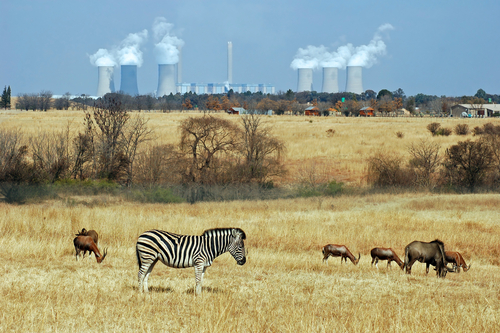 Toxic pollutants spewed into the air, or deposited on soils or bodies of water, can impact all forms of wildlife in a number of ways. Like us, animals can experience health problems from exposure to air toxins over time.
Studies show
that air toxins are contributing to birth defects, reproductive failure, and disease in animals and in some cases
wildlife populations have suffered severe losses or even faced extinction due to pollution. Persistent toxic air pollutants, which break down slowly in the environment resulting in extended duration, are of particular concern to marine ecosystems.
These pollutants accumulate in sediments and may biomagnify in tissues of animals
at the top of the food chain to concentrations many times higher than in the water or air. According to the
EPA, wildlife exposure to toxic pollutants such as dioxins and mercury have been associated with decreased fertility, decreased hatching success, damaged reproductive organs, and altered immune systems. Ozone, sulphur dioxide, nitrogen dioxide, heavy metals, dioxins and mercury
may affect the circulatory, respiratory, gastrointestinal, and central nervous systems of animals
and targeting organs such as the kidney, liver, and brain.
Entire populations can be affected
as metal contamination can cause changes in birth, growth, and death rates. The
acidification of oceans
and of smaller bodies of water all over the world, mainly due to carbon dioxide emissions, can lead to a decline in and loss of fish populations, ranging from the thousands of species of calcifying organisms to fish at the top of the food chain. In addition to affecting individual animals or populations directly, air pollutants also affect wildlife indirectly by causing changes to and damaging the ecosystems that they,
and we
, depend on.
Learn more.
Toxic pollutants spewed into the air, or deposited on soils or bodies of water, can impact all forms of wildlife in a number of ways. Like us, animals can experience health problems from exposure to air toxins over time.
Studies show
that air toxins are contributing to birth defects, reproductive failure, and disease in animals and in some cases
wildlife populations have suffered severe losses or even faced extinction due to pollution. Persistent toxic air pollutants, which break down slowly in the environment resulting in extended duration, are of particular concern to marine ecosystems.
These pollutants accumulate in sediments and may biomagnify in tissues of animals
at the top of the food chain to concentrations many times higher than in the water or air. According to the
EPA, wildlife exposure to toxic pollutants such as dioxins and mercury have been associated with decreased fertility, decreased hatching success, damaged reproductive organs, and altered immune systems. Ozone, sulphur dioxide, nitrogen dioxide, heavy metals, dioxins and mercury
may affect the circulatory, respiratory, gastrointestinal, and central nervous systems of animals
and targeting organs such as the kidney, liver, and brain.
Entire populations can be affected
as metal contamination can cause changes in birth, growth, and death rates. The
acidification of oceans
and of smaller bodies of water all over the world, mainly due to carbon dioxide emissions, can lead to a decline in and loss of fish populations, ranging from the thousands of species of calcifying organisms to fish at the top of the food chain. In addition to affecting individual animals or populations directly, air pollutants also affect wildlife indirectly by causing changes to and damaging the ecosystems that they,
and we
, depend on.
Learn more.
 Toxic pollutants spewed into the air, or deposited on soils or bodies of water, can impact all forms of wildlife in a number of ways. Like us, animals can experience health problems from exposure to air toxins over time.
Studies show
that air toxins are contributing to birth defects, reproductive failure, and disease in animals and in some cases
wildlife populations have suffered severe losses or even faced extinction due to pollution. Persistent toxic air pollutants, which break down slowly in the environment resulting in extended duration, are of particular concern to marine ecosystems.
These pollutants accumulate in sediments and may biomagnify in tissues of animals
at the top of the food chain to concentrations many times higher than in the water or air. According to the
EPA, wildlife exposure to toxic pollutants such as dioxins and mercury have been associated with decreased fertility, decreased hatching success, damaged reproductive organs, and altered immune systems. Ozone, sulphur dioxide, nitrogen dioxide, heavy metals, dioxins and mercury
may affect the circulatory, respiratory, gastrointestinal, and central nervous systems of animals
and targeting organs such as the kidney, liver, and brain.
Entire populations can be affected
as metal contamination can cause changes in birth, growth, and death rates. The
acidification of oceans
and of smaller bodies of water all over the world, mainly due to carbon dioxide emissions, can lead to a decline in and loss of fish populations, ranging from the thousands of species of calcifying organisms to fish at the top of the food chain. In addition to affecting individual animals or populations directly, air pollutants also affect wildlife indirectly by causing changes to and damaging the ecosystems that they,
and we
, depend on.
Learn more.
Toxic pollutants spewed into the air, or deposited on soils or bodies of water, can impact all forms of wildlife in a number of ways. Like us, animals can experience health problems from exposure to air toxins over time.
Studies show
that air toxins are contributing to birth defects, reproductive failure, and disease in animals and in some cases
wildlife populations have suffered severe losses or even faced extinction due to pollution. Persistent toxic air pollutants, which break down slowly in the environment resulting in extended duration, are of particular concern to marine ecosystems.
These pollutants accumulate in sediments and may biomagnify in tissues of animals
at the top of the food chain to concentrations many times higher than in the water or air. According to the
EPA, wildlife exposure to toxic pollutants such as dioxins and mercury have been associated with decreased fertility, decreased hatching success, damaged reproductive organs, and altered immune systems. Ozone, sulphur dioxide, nitrogen dioxide, heavy metals, dioxins and mercury
may affect the circulatory, respiratory, gastrointestinal, and central nervous systems of animals
and targeting organs such as the kidney, liver, and brain.
Entire populations can be affected
as metal contamination can cause changes in birth, growth, and death rates. The
acidification of oceans
and of smaller bodies of water all over the world, mainly due to carbon dioxide emissions, can lead to a decline in and loss of fish populations, ranging from the thousands of species of calcifying organisms to fish at the top of the food chain. In addition to affecting individual animals or populations directly, air pollutants also affect wildlife indirectly by causing changes to and damaging the ecosystems that they,
and we
, depend on.
Learn more.
Air pollution is damaging 60% of Europe's prime wildlife sites in meadows, forests and heaths. Learn more.
Ozone Depletion
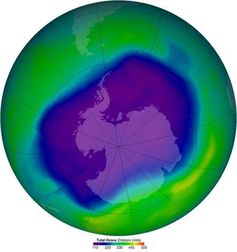
Ozone is a gas that occurs both at ground-level and in the Earth's upper atmosphere, known as the stratosphere, where ozone forms a layer that protects life on earth from the sun's harmful ultraviolet (UV) rays. This stratospheric ozone layer is gradually recovering from the onslaught of man-made chemicals referred to as
ozone-depleting substances, including chlorofluorocarbons, hydrochlorofluorocarbons, and halons. These substances were formerly used in mass, but are now largely banned by the
Montreal Protocol of 1989, although
according to the United Nations, some of these substances can still be used in aerosol products, as sterilants of medical equipment, and in a range of miscellaneous applications including food freezing, tobacco expansion, fumigation and cancer therapy. Thinning of the protective ozone layer can cause increased amounts of UV radiation to reach the Earth, which can lead to more cases of skin cancer, cataracts, and impaired immune systems. UV can also damage sensitive crops, such as soybeans, and reduce crop yields.
Learn more.
"There's so much pollution in the air now that if it weren't for our lungs there'd be no place to put it all." ~ Robert Orben
The Greatest Impact of Air Pollution is Global Climate Change
According to the EU's Environmental Agency, air pollution is more than just harmful - it's expensive too,
costing the EU more than $130 billion in 2009
.
Reduce Air Pollution

